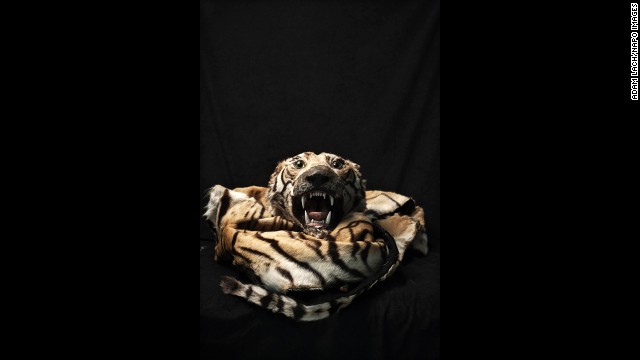http://edition.cnn.com/2014/12/02/world/cnnphotos-animal-trade/index.html?hpt=wo_bn4
The victims of the illegal wildlife trade
December 3, 2014 -- Updated 0207 GMT (1007 HKT)
STORY HIGHLIGHTS
- A Polish airport has an exhibit showing some of the illegal animal goods it has seized
- Photographer Adam Lachrecently took photos to document the problem
- He hopes to sensitize people and make them aware they're part of the problem
- View high-resolution photosof Lach's "Human Tsunami" project
(CNN) -- An elephant leg as a trash can. A crocodile skin for a bathroom carpet. A bear skin to help a man project power in the bedroom.
These are just some of the objects confiscated by Polish customs officers and documented by Adam Lach, a photographer and filmmaker at Napo Images.
For Lach, the illegal wildlife trade symbolizes the devastation that can result from human thoughtlessness, "which, like locusts, can destroy all we have around us."
Lach first learned about the illicit trade when he was a teenager in the 1990s. He was shocked by the stories he heard.
But it was seeing an exhibit of trafficked animal goods -- items seized by customs officials at an airport in Warsaw, Poland -- that prompted him to embark on his photographic project "Human Tsunami."

Adam Lach
"I am not an idealist, but in our world we have the belief that we are the only valuable existence on planet Earth -- and this is not acceptable," Lach said.
"The relation of men towards animals and nature is a reflection of the characteristics of the whole human population, as we still allow crimes against animals and nature. We do not understand that respecting the planet translates into respect of the people for themselves.
"Let us keep balance and let us use only what we need to live by. Cutting off the leg of an elephant and using it as a trash can is a testament to our hypocrisy."
Lach's pictures were mostly taken over a two-week period, although he anticipates taking more in the future. Some of the specimens shown were confiscated years ago at the Warsaw airport, which placed its exhibit in the middle of the departures terminal to raise awareness of the problem.
Cutting off the leg of an elephant and using it as a trash can is a testament to our hypocrisy.
Adam Lach
Adam Lach
Lach's images are not a story about a particular airport, he said, but they reflect a wider issue.
"Through these photographs, I will try to sensitize people and make them aware that they are often part of the problem," he said. "This project aims to show human arrogance and folly and to build in us humility.
"In my work I often use the sense of peace and tranquility in the photographs. I avoid screaming images. Hence the idea of a black background -- I wanted to isolate these exhibits to give them the rank of authenticity and pain.
"I wanted to pass on, as well, how uncomfortable I felt when I had to touch and set up these exhibits to be photographed or listen to horror stories of the customs officers."
One story that stood out in particular for Lach was that of a rapid decline in a seahorse species surrounding Indonesia.
"This decline came suddenly, out of nowhere," he recounted. "A short time afterwards, the Polish customs officers intercepted a cargo of dried seahorses. It turned out that some Indonesian company exported them to Poland as dietary supplements, a total of 27 tons of seahorses.
"How many seahorses had to die to produce 27 tons of powder? Millions. That almost threatened the extinction of the entire population, perhaps even more than one species.
"It shows how easy it is to cause irreparable damage to nature and how stupid we are."
Polish customs officers have done well in combating the trade, Lach said. They no longer find cardboard boxes filled with hundreds of turtles, or parrot cages containing tied-up birds, or containers of snakes and lizards that are stuffed so full that only half survived the trip, he said.
Now, smuggling efforts are more likely to involve someone trying to transport a baby monkey or pass off a serval -- an African wild cat -- as a domestic cat, he said.
"At first glance, it seems therefore that it is better. But it is not," Lach said. "This illegal trade is running as before, even faster, only ever more discreetly.
"Before, this trade flourished in markets and pet stores, while today traders often use the Internet. It is not only convenient, but also safer. The merchant offers for sale one or two pieces, sends them by courier, and if there is a setback, the loss is small.
"The criminal responsibility is smaller too, because it deals with smuggling a single specimen. Illegal transactions favor the Internet. A global network does not recognize borders."
Today, Lach said, anyone with an Internet connection can visit the traffickers' websites.
"The only limitation is language," he said. "One who knows languages can buy everything."
 A tiger skin is among the illegal items that have been confiscated over the years at Warsaw Chopin Airport in Warsaw, Poland. Photographer Adam Lach recently documented some of the items as part of his project "Human Tsunami."
A tiger skin is among the illegal items that have been confiscated over the years at Warsaw Chopin Airport in Warsaw, Poland. Photographer Adam Lach recently documented some of the items as part of his project "Human Tsunami."
沒有留言:
張貼留言